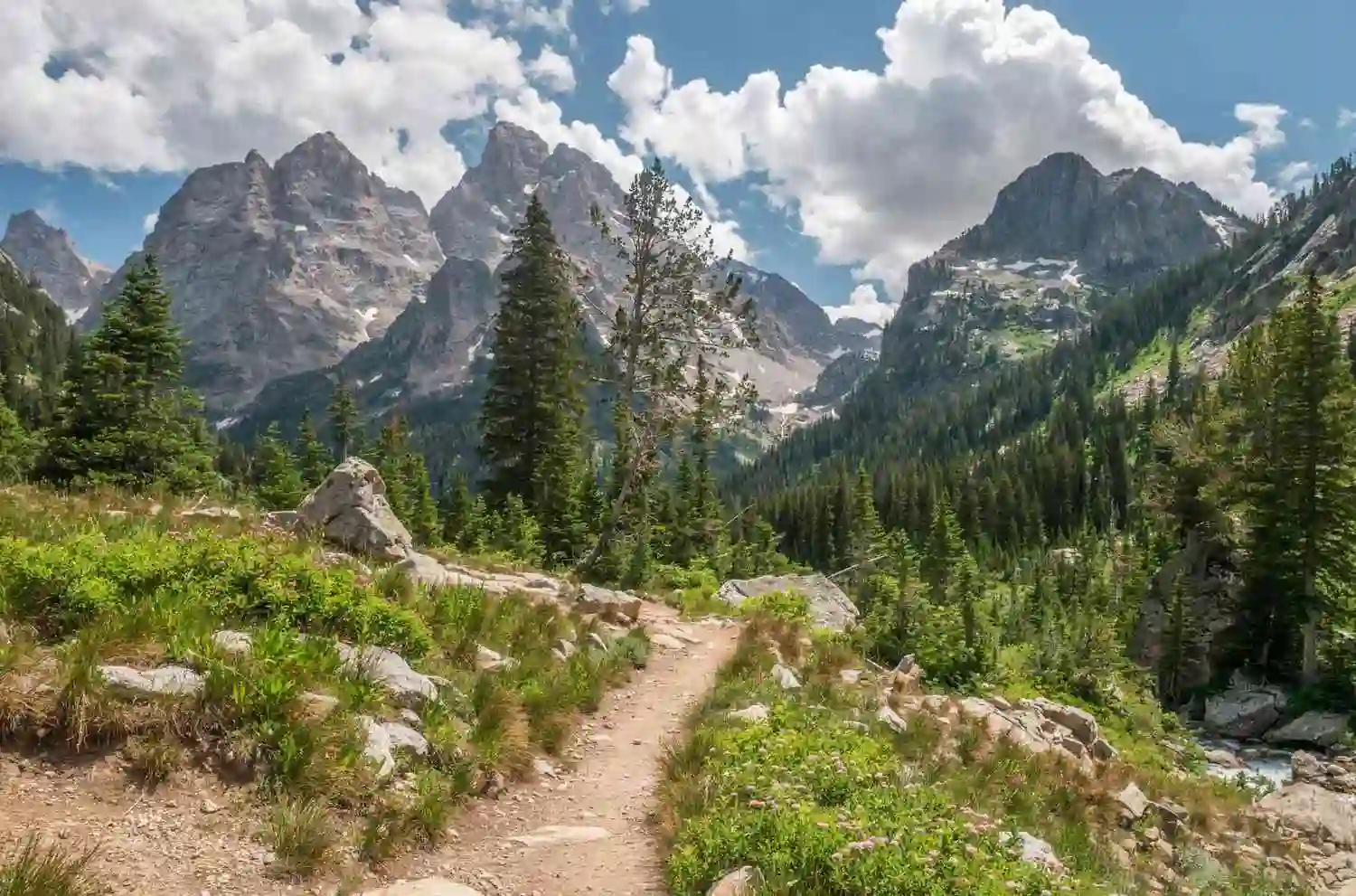Green Teton National Park
Grand Teton National Park, situated in Wyoming’s western expanse, embodies nature’s magnificence. The park’s allure lies in the commanding presence of the Teton Range, an awe-inspiring series of peaks that dominate the skyline. This iconic sanctuary enthralls visitors with its untamed landscapes, crystalline alpine lakes, verdant forests, and an abundance of wildlife thriving in its diverse ecosystems. As a haven for outdoor enthusiasts and seekers of natural beauty, Grand Teton National Park promises an unforgettable journey into the heart of unspoiled wilderness and breath taking vistas.
Grand Teton National Park History
Grand Teton National Park boasts a rich and diverse history steeped in both natural wonder and human endeavour. Before becoming a park, these lands were inhabited by indigenous tribes like the Shoshone, Crow, and Bannock, who revered the towering peaks and abundant wildlife. In the late 19th and early 20th centuries, settlers arrived, drawn by the fertile valleys for ranching and farming.
Conservation efforts led to the establishment of the park, though it faced challenges as private landowners initially resisted incorporation. John D. Rockefeller Jr. played a pivotal role by purchasing and donating large parcels of land, facilitating the park’s expansion.
Finally, in 1929, Grand Teton National Park was established, preserving not just the stunning landscapes but also honoring the historical and cultural significance of this cherished region.
Grand Teton National Park Facts
some fascinating facts about Grand Teton National Park:
- Iconic Peaks: The Teton Range, with its jagged peaks, is the centerpiece of the park, including Grand Teton, rising over 13,700 feet.
- Abundant Wildlife: The park is home to diverse wildlife, including grizzly bears, black bears, elk, moose, and elusive mountain lions.
- Pristine Lakes: Glacially carved lakes like Jenny Lake and Jackson Lake offer stunning reflections of the surrounding peaks.
- Mountaineering Haven: It’s a mecca for climbers, with challenging routes attracting climbers from across the globe.
- Historical Significance: Native American tribes once roamed these lands, leaving behind rich cultural legacies.
- Protected Wilderness: Established in 1929 and expanded in 1950, the park preserves 310,000 acres of unspoiled natural beauty.
Best Time to visit Grand Teton National Park
The best time to visit Grand Teton National Park largely depends on personal preferences and desired activities. The summer months, from June to August, offer warm weather, open roads, and access to hiking trails and boat tours.
Wildlife is also abundant during this time. Fall, from September to October, showcases stunning foliage, fewer crowds, and opportunities for wildlife viewing as animals prepare for winter. Winter, from December to March, transforms the park into a winter wonderland, ideal for snowshoeing, skiing, and enjoying serene landscapes.
Spring, from April to May, welcomes blooming wildflowers and reawakening wildlife. However, some trails and facilities may still be closed due to lingering snow. Each season brings its own unique charm, so choosing the best time depends on preferred activities and the type of experience one seeks.
Also Read – Death Valley, Best National Parks USA – Dare to Challenge the Elements?
Grand Teton National Park to Yellowstone

Connecting two iconic national parks, the journey from Grand Teton National Park to Yellowstone National Park is a scenic marvel in itself. The John D. Rockefeller, Jr. Memorial Parkway links these parks, providing a seamless transition between the two. Travelers can embark on a picturesque drive along the John D. Rockefeller, Jr. Memorial Parkway, spanning roughly 30 miles, showcasing breathtaking vistas of the Teton Range and winding through lush forests.
Exiting Grand Teton’s southern boundary, visitors enter Yellowstone through the South Entrance, marking the start of an adventure in the world’s first national park. The drive allows exploration of Yellowstone’s wonders, including geysers, hot springs, and diverse wildlife. The proximity of these parks offers an opportunity to experience the distinct geological marvels and ecosystems each park offers, making it a remarkable journey through the natural wonders of the American West.
Directions to Grand Teton National Park
To reach Grand Teton National Park, several entrances provide access to different areas within the park.
From the north, take Highway 89/191/287 through Yellowstone National Park or enter directly from the town of Jackson, Wyoming, via Highway 191/26/89. If arriving from the east, use Highway 26/89/191 through Dubois or Highway 287/26/89 through Moran Junction.
Travelers from the south can access the park through the town of Jackson via Highways 191/26/89. From the west, take Highway 22/390 through Victor and Wilson or Highway 33/22 through Driggs, Idaho.
Once inside the park, various roads connect different areas, offering access to scenic overlooks, campgrounds, hiking trails, and visitor centers, providing an array of experiences amidst the breathtaking landscapes of Grand Teton National Park.
Also Read – Travel Destinations USA – Glacier National Park, Best National Parks USA.
Grand Teton National Park Camping
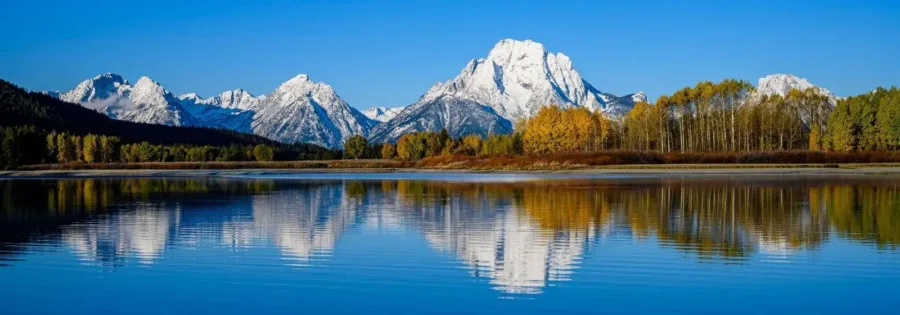
Grand Teton National Park offers a variety of camping experiences amidst its stunning landscapes. With several campgrounds scattered throughout the park, visitors can immerse themselves in nature’s embrace. Reservations are recommended, especially during the peak summer season when campgrounds fill up quickly.
Gros Ventre Campground, situated near the Gros Ventre River, provides a rustic camping experience with serene surroundings. Colter Bay Campground offers stunning views of Jackson Lake and convenient access to water activities. Jenny Lake Campground, nestled near the iconic lake, offers a more secluded and intimate camping experience.
For a backcountry adventure, permits are required, allowing hikers to camp in designated areas away from the developed campgrounds, providing an unparalleled wilderness experience under the starlit sky. Whether in the heart of the park or the backcountry, camping in Grand Teton National Park promises an unforgettable connection with nature.
Colter Bay Campground
Colter Bay Campground, nestled along the shores of Jackson Lake in Grand Teton National Park, offers a picturesque setting for camping enthusiasts. With over 300 campsites accommodating tents, RVs, and trailers, it provides stunning views of the Tetons and easy access to water activities.
Amenities include showers, laundry facilities, a grocery store, and nearby dining options. The proximity to hiking trails, boat rentals, and the Colter Bay Visitor Center adds to its allure, making it a popular choice for those seeking both natural beauty and convenient amenities during their stay in the park.
Grand Teton National Park rv Camping
Grand Teton National Park welcomes RV enthusiasts with several campgrounds offering RV accommodations and facilities. Colter Bay RV Park presents over 100 RV sites with full hookups, nestled near Jackson Lake and surrounded by the park’s majestic scenery. Gros Ventre Campground also provides RV-friendly sites, offering a more rustic experience along the Gros Ventre River.
While there are length restrictions in some campgrounds, amenities like dump stations, water, and electrical hookups cater to RV travelers, ensuring a comfortable stay amidst the breathtaking beauty of Grand Teton National Park. Reservations are recommended, especially during the peak season, to secure a spot for RV camping.
Gros Ventre Campground
Gros Ventre Campground, located in Grand Teton National Park, offers a serene retreat along the meandering Gros Ventre River. With over 300 campsites, it caters to tents and RVs, providing a rustic camping experience amidst nature’s splendor.
The campground’s open meadows and proximity to wildlife viewing areas add to its allure. Facilities include drinking water, restrooms, and nearby access to hiking trails. Its idyllic setting and spacious sites make Gros Ventre Campground a popular choice for those seeking a tranquil escape while still being close to the park’s wonders, offering an authentic camping experience in the heart of Grand Teton’s wilderness.
Also Read – Living and Breathing Marvel : Redwood National Park, Best National Parks USA.
Lizard Creek Campground
Lizard Creek Campground, nestled on the northern shores of Jackson Lake in Grand Teton National Park, offers a tranquil setting for outdoor enthusiasts. With around 60 campsites, it caters to tents and RVs, providing a serene atmosphere surrounded by nature’s beauty. The campground’s proximity to the lake allows for various water activities like fishing and kayaking. Basic amenities include restrooms and drinking water, and its location near hiking trails and scenic viewpoints adds to its appeal. Lizard Creek Campground is ideal for those seeking a quieter camping experience while still enjoying the stunning landscapes of Grand Teton National Park.
Signal Mountain Campground
Signal Mountain Campground, perched atop Signal Mountain in Grand Teton National Park, offers a breathtaking vista of Jackson Lake and the Teton Range. With approximately 80 campsites catering to tents and RVs, it provides a unique blend of natural beauty and convenience.
The campground’s wooded surroundings and proximity to scenic overlooks create a serene ambiance. Basic amenities like restrooms and potable water are available, and its location near hiking trails and the Signal Mountain Lodge enhances the camping experience. Signal Mountain Campground is a sought-after spot for its stunning views and easy access to both outdoor adventures and modern facilities within the park.
Free Camping Grand Teton National Park
Finding free camping near Grand Teton National Park can be challenging within the park boundaries due to regulations. However, dispersed camping on nearby public lands like Bridger-Teton National Forest or Bureau of Land Management areas might offer options for primitive camping without fees.
Be sure to follow specific regulations regarding dispersed camping, including Leave No Trace principles, staying at designated sites, and obtaining necessary permits where required. These areas may offer a more rustic experience, providing opportunities for secluded camping while being in proximity to Grand Teton’s stunning landscapes.
Grand Teton National Park Camping Reservations
To secure camping reservations in Grand Teton National Park, it’s advisable to plan ahead, especially during the peak season from June to August. Reservations for campgrounds within the park, such as Colter Bay, Jenny Lake, Gros Ventre, and Signal Mountain, can be made through the official National Park Service website or by calling the park’s reservation line. Reservations typically open several months in advance, and early booking is recommended due to high demand.
Additionally, some campsites operate on a first-come, first-served basis, but availability can be limited, especially during busy periods. Planning and reserving ahead ensure a more relaxed and enjoyable camping experience amidst the natural wonders of Grand Teton National Park.
Grand Teton National Park Lodging
Grand Teton National Park offers various lodging options catering to different preferences. Accommodations within the park include historic lodges, cabins, and campgrounds. The Jackson Lake Lodge, perched on a bluff overlooking Jackson Lake, offers comfortable rooms and stunning views. Colter Bay Village provides cabins, tent cabins, and RV sites near Jackson Lake. Jenny Lake Lodge offers rustic elegance with private cabins nestled in the woods.
For those seeking a more primitive experience, several campgrounds offer tent and RV sites, such as Signal Mountain Campground and Gros Ventre Campground. Additionally, the nearby town of Jackson, Wyoming, provides numerous hotels, motels, and vacation rentals, offering additional options for lodging near the park. Reservations for in-park lodging are recommended, especially during the peak summer season, to ensure availability and a memorable stay amidst the natural beauty of Grand Teton National Park.
Also Read – Travel Destinations USA – Acadia National Park, “Unravelling the majestic secrets”, Best National Parks USA
Grand Teton National Park Things to do
Best hikes in Grand Teton National Park
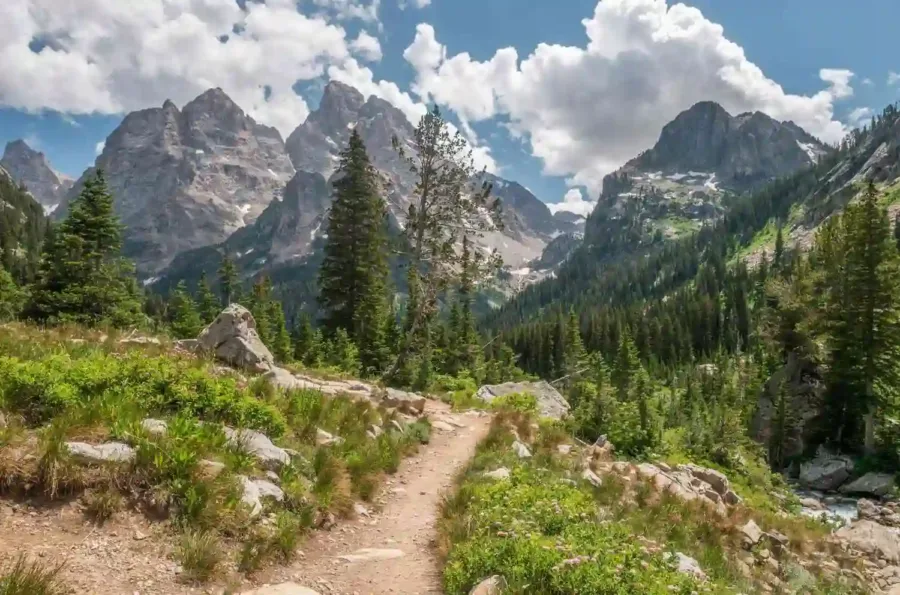
Grand Teton National Park boasts an array of captivating hikes catering to various skill levels and interests. Cascade Canyon Trail presents stunning views of the Teton Range, starting from Jenny Lake and offering glimpses of waterfalls and alpine lakes. The challenging but rewarding hike up to Inspiration Point and Hidden Falls begins at the Jenny Lake Trailhead.
The Taggart Lake and Bradley Lake Loop is a moderate trail showcasing serene lakes and breathtaking mountain scenery. For a more strenuous trek, the hike to Amphitheater and Surprise Lakes rewards hikers with secluded alpine lakes and panoramic vistas.
The Paintbrush-Cascade Canyon Loop is a challenging yet iconic hike, showcasing diverse landscapes, vibrant wildflowers, and close encounters with wildlife. Each trail in Grand Teton National Park offers a unique experience, showcasing the park’s natural beauty and captivating landscapes.
Grand Teton hike
The Grand Teton hike, a pinnacle of mountaineering in Grand Teton National Park, is an iconic and challenging ascent. Starting from the Lupine Meadows Trailhead, this technical climb requires rock climbing skills, route finding, and knowledge of alpine environments. Ascending nearly 7,000 feet, climbers navigate exposed sections, steep terrain, and potentially hazardous conditions. The climb culminates at the summit of Grand Teton, rewarding adventurers with unparalleled views of the Teton Range and surrounding landscapes. Due to its difficulty and technical nature, climbers often engage experienced guides or undergo thorough preparation. The Grand Teton hike stands as a revered achievement, drawing climbers from around the world to conquer its majestic peak and savor the ultimate mountaineering experience.
Cascade Canyon Trail
The Cascade Canyon Trail in Grand Teton National Park is a captivating hike renowned for its stunning scenery and diverse landscapes. Starting from the Jenny Lake Trailhead, this popular trail winds alongside the crystal-clear waters of Jenny Lake before leading into Cascade Canyon. Hikers are treated to breathtaking views of rugged peaks, lush forests, and cascading waterfalls along the way.
The trail offers various options, from a moderate stroll to challenging extensions like the hike to Hidden Falls and Inspiration Point. The distance and difficulty can be tailored to suit different preferences, making it accessible to a wide range of hikers. Wildlife sightings, including moose and bears, are not uncommon in this picturesque canyon. Cascade Canyon Trail stands as a must-do for visitors seeking an unforgettable trek through the unparalleled beauty of Grand Teton National Park.
Lakeshore Trail
The Lakeshore Trail in Grand Teton National Park offers a serene and scenic experience along the shores of Jackson Lake. Beginning near the Colter Bay Village area, this relatively flat trail meanders along the lake’s shoreline, providing breathtaking vistas of the Teton Range reflected in the tranquil waters. The trail is perfect for leisurely walks, runs, or cycling, offering glimpses of diverse flora, including wildflowers and cottonwood trees. With multiple access points, hikers can customize the length of their journey, from short strolls to longer excursions.
The trail’s peaceful ambiance and captivating views make it an ideal spot for picnics, birdwatching, and soaking in the beauty of the surrounding landscapes. Whether seeking a leisurely lakeside stroll or a peaceful retreat amidst nature, the Lakeshore Trail delivers a memorable experience in the heart of Grand Teton National Park.
Jenny Lake Trail
The Jenny Lake Trail in Grand Teton National Park offers a picturesque and accessible hike around the stunning Jenny Lake. This popular trail provides breathtaking views of the lake’s azure waters, framed by the towering Teton peaks. Beginning near the Jenny Lake Visitor Center, the trail offers various routes, including the option to reach Hidden Falls and Inspiration Point. With well-maintained pathways and scenic viewpoints, it’s an ideal hike for visitors of all ages and skill levels. The trail’s proximity to the lake and captivating scenery make it a must-do experience to immerse oneself in the natural splendor of Grand Teton.
Teton Crest Trail
The Teton Crest Trail in Grand Teton National Park is a premier backpacking adventure spanning roughly 40 miles through the heart of the Teton Range. Starting at Phillips Pass and concluding near Cascade Canyon or Paintbrush Canyon, this challenging trek offers breathtaking views of alpine meadows, towering peaks, and pristine lakes. Hikers traverse high mountain passes, including Hurricane Pass and Paintbrush Divide, experiencing diverse landscapes and abundant wildlife. This multi-day expedition requires backcountry camping permits, offers rewarding challenges, and stands as a pinnacle for outdoor enthusiasts seeking an immersive journey through the rugged and awe-inspiring terrain of Grand Teton National Park.
Schwabacher Landing
Schwabacher Landing in Grand Teton National Park is a photographer’s paradise and a serene spot for nature enthusiasts. This iconic location along the Snake River offers stunning reflections of the Teton Range in the water, especially during sunrise and sunset. Accessible via a short trail from the parking area, it provides an unobstructed view of the mountains and opportunities to spot wildlife like moose and beavers. Photographers flock here for the mirror-like reflections and the tranquil ambiance, making it a must-visit destination for those seeking to capture the natural beauty and tranquility of Grand Teton’s landscapes.
Lake Solitude
Lake Solitude in Grand Teton National Park is a breathtaking alpine gem nestled within the heart of the Teton Range. Accessible via the challenging but rewarding Cascade Canyon Trail, this pristine lake captivates hikers with its serene beauty and awe-inspiring surroundings. Surrounded by rugged peaks and lush meadows, the lake offers a serene escape for those seeking solitude in nature. Its crystal-clear waters reflect the towering mountains, creating a picturesque setting that rewards adventurers who make the journey. Lake Solitude stands as a peaceful sanctuary, inviting hikers to immerse themselves in the tranquil grandeur of Grand Teton’s backcountry.
Phelps Lake
Phelps Lake, nestled in Grand Teton National Park, enchants visitors with its tranquil allure and scenic vistas. Accessible via the Death Canyon Trailhead or the shorter hike from Laurance S. Rockefeller Preserve, this serene lake offers a peaceful retreat. Its pristine waters are surrounded by forests and cliffs, creating a picturesque setting for picnics, swimming, or simply soaking in the beauty. Hikers can explore the Phelps Lake Overlook for panoramic views or venture along the shoreline for a closer connection with nature. With its captivating scenery and accessible trails, Phelps Lake invites exploration and relaxation amidst the natural splendor of Grand Teton National Park.
Delta Lake Trail
Delta Lake, a hidden gem in Grand Teton National Park, rewards intrepid hikers with a stunning alpine oasis. Accessible via the challenging but thrilling Delta Lake Trail, this turquoise gem is tucked amidst rugged terrain and towering cliffs. The trail ascends through steep terrain and boulder fields, offering panoramic vistas of the park. Delta Lake captivates adventurers with its crystal-clear waters reflecting the surrounding peaks, providing a serene spot for relaxation or a refreshing dip. Its secluded location and dramatic beauty make it a cherished destination for those seeking a rugged and rewarding backcountry adventure in the heart of Grand Teton’s wilderness.
String Lake Hike
The String Lake hike in Grand Teton National Park is a scenic and accessible trail suitable for all skill levels. Beginning at the String Lake Trailhead, this picturesque loop trail encircles the tranquil String Lake. Hikers can enjoy stunning views of the Teton Range reflected in the clear waters and explore nearby picnic areas. The trail offers opportunities for swimming, kayaking, or simply relaxing by the lakeshore. Its level terrain and captivating scenery make it ideal for families, leisurely walks, or those seeking a peaceful nature retreat amidst the beauty of Grand Teton’s landscapes.
Leigh Lake
Leigh Lake in Grand Teton National Park is a serene and captivating destination embraced by the park’s natural beauty. Accessible via the Leigh Lake Trail, this tranquil spot offers breathtaking views of the Teton Range mirrored in its crystal-clear waters. Hikers can embark on a leisurely stroll along the shoreline or venture deeper into the backcountry trails. The lake’s peaceful ambiance makes it ideal for picnics, fishing, or simply soaking in the serene surroundings. Its accessibility and stunning vistas make Leigh Lake a cherished destination for visitors seeking a serene escape amidst the majestic landscapes of Grand Teton National Park.
Taggart Lake
Taggart Lake, nestled in Grand Teton National Park, offers a serene escape amidst stunning natural beauty. Accessible via the Taggart Lake Trailhead, this moderate hike leads through peaceful forests and open meadows, treating hikers to panoramic views of the Teton Range. The tranquil lake, framed by the majestic peaks, invites visitors to relax by its shores, fish, or admire the reflections of the mountains on its pristine waters. With its accessibility and captivating vistas, Taggart Lake stands as a cherished destination for those seeking a scenic hike and a serene connection with nature in the heart of Grand Teton’s wilderness.
Laurance S. Rockefeller Preserve and Visitor Center
The Laurance S. Rockefeller Preserve and Visitor Center in Grand Teton National Park offer a serene and educational experience within the park’s lush landscapes. Named after conservationist Laurance S. Rockefeller, this preserve showcases his commitment to preserving natural environments. The visitor center provides insights into the park’s ecology and Rockefeller’s conservation legacy.
Trails within the preserve, like the Phelps Lake Loop, offer scenic hikes through forests and meadows, leading to stunning vistas. Educational exhibits highlight the park’s biodiversity and conservation efforts, engaging visitors in understanding and appreciating the delicate ecosystem. With its tranquil setting, interpretive displays, and well-maintained trails, the Laurance S. Rockefeller Preserve and Visitor Center invite visitors to immerse themselves in nature’s splendor while learning about the park’s rich heritage and conservation initiatives.
Drive Moose-Wilson Road
Moose-Wilson Road in Grand Teton National Park offers a scenic drive through pristine landscapes and abundant wildlife habitats. This unpaved road winds through forests and wetlands, providing opportunities to spot diverse wildlife such as moose, bears, and birds. The route offers picturesque views of the Teton Range and meanders along the Snake River, offering glimpses of the area’s natural beauty. However, it’s essential to note that the road may have seasonal closures or restrictions to preserve the sensitive ecosystem, so it’s advisable to check current conditions before planning a drive along Moose-Wilson Road for an immersive experience in the park’s serene wilderness.
Teton Village at Jackson Hole
Teton Village, adjacent to Jackson Hole Mountain Resort, is a vibrant hub offering an array of attractions and activities in the shadow of the Teton Range. This bustling alpine village provides year-round adventures, from world-class skiing and snowboarding in winter to mountain biking and hiking in summer. The charming village center boasts diverse dining options, shopping boutiques, and après-ski spots. Visitors can ride the Aerial Tram to enjoy panoramic views, engage in outdoor concerts, or unwind at luxurious spas. With its proximity to Grand Teton National Park, Teton Village serves as a gateway for outdoor enthusiasts, offering a perfect blend of adventure, entertainment, and relaxation amidst the stunning mountain scenery of Jackson Hole.
Chapel of the Transfiguration
The Chapel of the Transfiguration, nestled in Grand Teton National Park, is a serene and historic sanctuary offering spiritual solace amidst breathtaking landscapes. This picturesque chapel, constructed in 1925, frames the majestic Teton Range through its large window behind the altar, creating a captivating natural backdrop for worshipers. Visitors appreciate its rustic charm, simple architecture, and peaceful ambiance.
The chapel hosts regular services during the summer months, welcoming visitors of all denominations. Its serene setting and stunning views make it a favored spot for quiet reflection, photography, or attending the occasional wedding ceremony. The Chapel of the Transfiguration stands as a cherished gem, inviting visitors to experience tranquility and spiritual connection within the awe-inspiring beauty of Grand Teton’s landscapes.
Mormon Row Historic District
The Mormon Row Historic District in Grand Teton National Park preserves a glimpse of the area’s early homesteading history. These iconic barns and homesteads, built by Mormon settlers in the early 1900s, stand as a testament to the region’s agricultural heritage. The picturesque setting against the backdrop of the Teton Range offers stunning photography opportunities, especially during sunrise or sunset.
Visitors can explore the rustic structures, imagining the challenges and triumphs of the families who once called this area home. Mormon Row remains a cherished site, providing a glimpse into the past and showcasing the enduring legacy of early settlers in the park’s breathtaking landscape.
42 mile scenic loop drive
The 42-mile scenic loop drive in Grand Teton National Park is an enchanting journey through the park’s diverse landscapes and iconic vistas. Starting from Moose Junction, the route winds along Teton Park Road, offering breathtaking views of the Teton Range, meadows, and serene lakes like Jenny Lake and Jackson Lake. The drive continues through lush forests, past historic sites like Mormon Row, and along the Snake River, providing opportunities to spot wildlife such as moose, elk, and bald eagles. Scenic viewpoints like Oxbow Bend and Snake River Overlook offer captivating photo opportunities of the majestic mountains reflected in the water. This picturesque drive encapsulates the park’s natural splendor, providing an immersive experience in the heart of Grand Teton’s stunning scenery.
Fishing in Grand Teton National Park
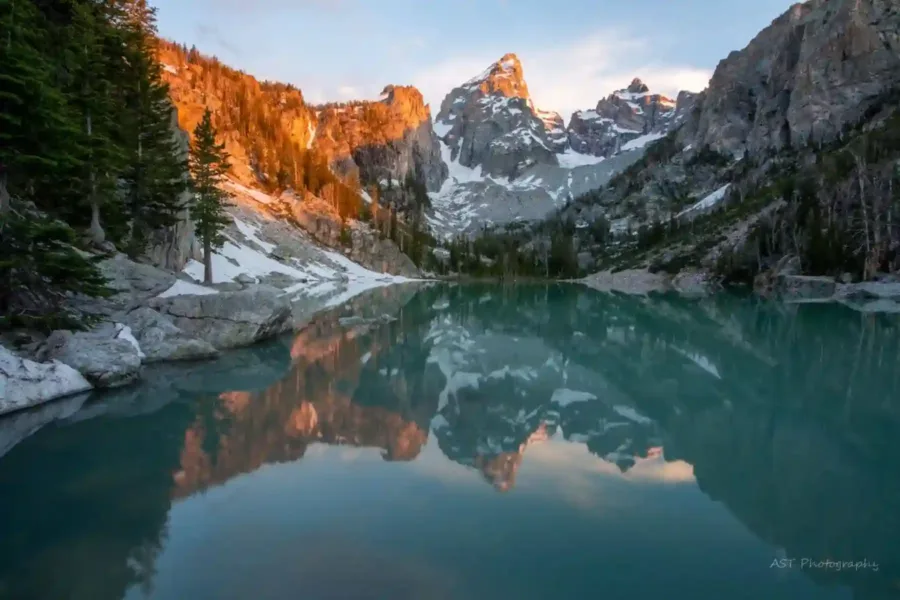
Fishing in Grand Teton National Park is a beloved activity amidst its pristine waters and diverse ecosystems. The park offers opportunities for anglers to cast their lines into lakes, rivers, and streams teeming with trout, including cutthroat, brown, and rainbow trout. Popular fishing spots include the Snake River, Jackson Lake, and Jenny Lake, where visitors can reel in various fish species while surrounded by stunning landscapes. Fishing regulations and permits are in place to preserve the park’s natural balance and ensure sustainable practices. Whether seeking a peaceful lakeside experience or a thrilling river adventure, fishing in Grand Teton National Park promises both relaxation and excitement amidst its unparalleled scenic beauty.
Wildlife in Grand Teton National Park
Grand Teton National Park is a haven for wildlife enthusiasts, boasting diverse ecosystems that support a rich array of animal species. The park is renowned for iconic megafauna like moose, elk, bison, and pronghorn, often spotted grazing in open meadows. Bears, including grizzlies and black bears, roam the forests, while elusive mountain lions and wolves traverse the rugged terrain.
Birdwatchers delight in spotting bald eagles, ospreys, and various bird species along lakeshores and in wetlands. Smaller creatures like marmots, pikas, and beavers thrive in their respective habitats. The park’s varied landscapes, from alpine forests to sagebrush flats, provide a home for an incredible diversity of wildlife, making every visit an opportunity for memorable encounters with nature’s inhabitants.
Grand Teton National Park Map
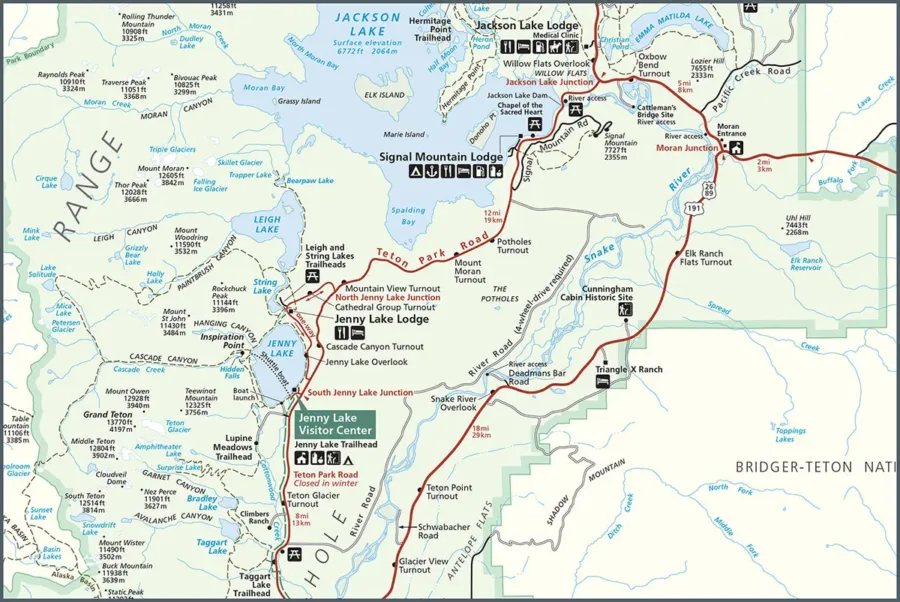
Best restaurants in Grand Teton National Park
Grand Teton National Park offers a variety of dining options:
- Jackson Lake Lodge: Features elegant dining with stunning views of the Teton Range.
- Jenny Lake Lodge: Offers a fine dining experience in a rustic setting.
- Signal Mountain Lodge: Provides casual dining options with beautiful lake views.
- Colter Bay Village: Offers more casual eateries and cafeterias for a quick bite. These options ensure visitors can enjoy meals ranging from upscale dining to more relaxed and casual atmospheres while exploring the park.
Grand Teton National Park Visiting Hours
Grand Teton National Park is open 24 hours a day, year-round. However, specific facilities, visitor centers, campgrounds, and roads within the park may have varying operating hours and seasonal closures. Entrance gates are typically accessible at all hours, allowing visitors to explore the park’s scenic beauty and outdoor activities at their convenience. It’s advisable to check the park’s official website or contact the visitor center for updated information regarding operating hours, road conditions, and any temporary closures before planning a visit to ensure a smooth and enjoyable experience in Grand Teton National Park.
Grand Teton National Park Entrance Fees
Overview of the entrance passes, fees, fee-free days, and information about commercial tour authorization:
Entrance Passes:
- America the Beautiful Annual Pass: Covers over 2,000 federal sites, including national parks, for $80, granting access to various federal recreation areas.
- Standard Entrance Pass: Required for Grand Teton National Park, ranges from $20 to $35 depending on the vehicle or individual.
- Annual Entrance – Park: Costs $70 and is valid for a year, allowing entry for a private non-commercial vehicle and its passengers.
Fee-Free Days in 2023:
- Martin Luther King Jr. Day
- First Day of National Park Week
- The Great American Outdoors Act
- National Public Lands Day
- Veterans Day
Commercial Tour Authorization (CUA):
- Implementation for standardized commercial tour fees is delayed. Updates are available on the National Park Service website.
Reservations:
- Lodging and Campgrounds: All lodging and campsites are reservable. Book in advance, as accommodations can fill up several months ahead. No reservations are required for park entry.
